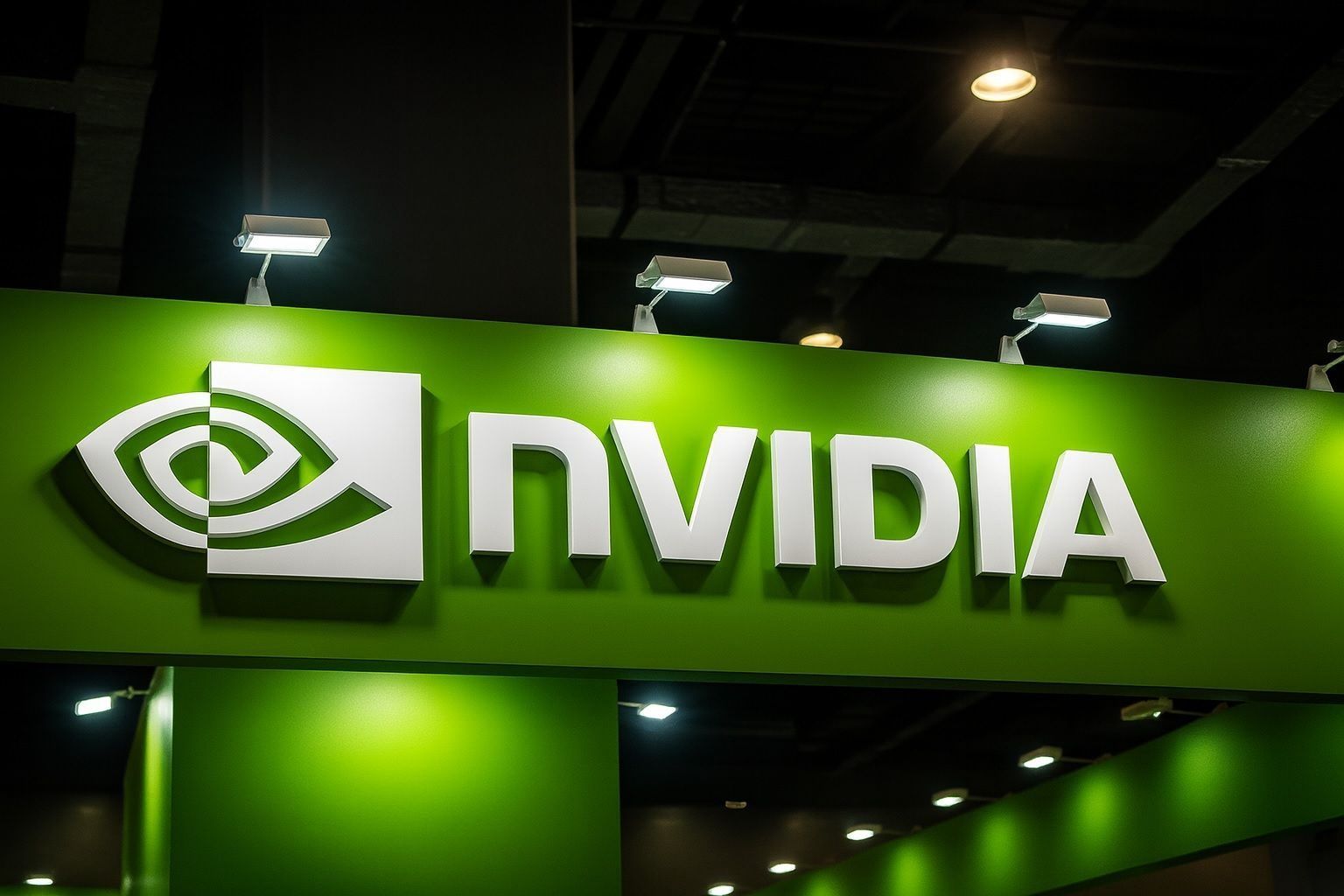Nvidia stock (NVDA) is trading higher on November 17, 2025 as investors worldwide focus on Wednesday’s Q3 earnings, fresh AI demand headlines, Chinese export‑control workarounds, and big-name investors like Peter Thiel exiting the stock. Here’s everything moving Nvidia today.
Nvidia stock price today (NVDA) – 17 November 2025
Nvidia shares are trading higher today as markets kick off what many analysts call the most important earnings week of the year for AI.
- Last price: around $190 per share
- Daily gain: roughly +1.7–1.8% vs. Friday’s close (about +$3.3) [1]
- Intraday range so far: roughly $180.40 – $191.06 on the Nasdaq, according to real‑time brokerage data [2]
- Market cap: about $4.6 trillion
- 52‑week range:$86.62 – $212.19 [3]
Data from MarketBeat shows Nvidia opening the session near $190.17 with a price‑to‑earnings (P/E) ratio a bit above 54 and a P/E/G ratio under 1.5, underscoring how much growth is already priced into the stock. [4]
At the index level, U.S. stock futures were already higher before the open, with the Nasdaq 100 climbing close to 1% in pre‑market trading as investors positioned ahead of Nvidia’s report and key U.S. jobs data later this week. [5]
Why Nvidia is the centre of the market today
Across global markets, Nvidia is the story of the week:
- Reuters notes that stocks and bond yields are broadly steady as traders wait to see whether the $5 trillion chipmaker’s earnings reignite or puncture the AI trade. [6]
- A separate Reuters “Morning Bid” column says Nvidia’s upcoming numbers are “shaping as a test for the artificial‑intelligence bull run”, with the stock’s performance seen as a key gauge of how sustainable AI spending really is. [7]
- The Economic Times describes the entire U.S. market outlook for November 17–21 as hinging on Nvidia plus fresh economic data and Federal Reserve minutes, calling the company a proxy for AI sector health. [8]
In short, today’s move in NVDA is less about today’s numbers and more about Wednesday’s.
Earnings preview: what Wall Street expects from Nvidia on November 19
Nvidia reports Q3 FY26 results on Wednesday, November 19, 2025 at 2:00 p.m. Pacific Time, according to the company’s own investor calendar. [9]
Across multiple sources, expectations are extremely high:
- Analysts expect revenue of roughly $54.8–$54.9 billion for the quarter, up from about $35.1 billion a year ago – a jump of ~56% year‑over‑year. [10]
- Adjusted EPS is projected around $1.25, versus roughly $0.81 in the prior‑year quarter, implying more than 50% EPS growth. [11]
- Reuters, using LSEG data, pegs consensus EPS growth at about 53.8% YoY, reinforcing the theme that Nvidia needs another blockbuster report just to meet expectations. [12]
On top of that:
- Bank of America has reiterated a Buy rating on Nvidia with a $275 price target, calling the valuation “compelling” even after the massive run‑up, and arguing that AI capex concerns may ease once the company updates its outlook. [13]
- Oppenheimer recently raised its Nvidia target from $225 to $265, saying the chipmaker “remains best positioned to win in AI” and highlighting strong demand for its data‑center GPUs. [14]
Investopedia and Investing.com both note that Nvidia shares are up around 40% year‑to‑date, which means the stock is entering earnings off an already‑strong base. [15]
Bottom line: the market is pricing in another huge quarter. Anything less than strong guidance and upbeat commentary on AI spending could disappoint.
Fresh institutional moves: Peter Thiel exits, funds trim Nvidia
One big subplot today is who is selling – and why.
Peter Thiel dumps his entire Nvidia stake
A widely shared piece from Indonesian outlet Pintu, based on U.S. 13F filings, shows that billionaire investor Peter Thiel’s fund sold all 537,000 Nvidia shares it held in Q3 2025. [16]
Key points from that report:
- Thiel’s Nvidia sale coincided with the company crossing roughly $5 trillion in market value and posting a 56% jump in data‑center revenue in a prior quarter. [17]
- After slashing Nvidia and trimming Tesla, Thiel’s total equity portfolio reportedly shrank by around 65%, and now consists mainly of Microsoft, Apple, and Tesla. [18]
- The article ties the move back to Thiel’s earlier warnings that AI is in a “hype loop”, with valuations potentially running ahead of fundamentals. [19]
An Economic Times piece echoes this theme, noting that Thiel’s exit adds to broader AI‑bubble jitters among some high‑profile investors. [20]
Other funds are quietly taking profits
MarketBeat highlights additional position trimming by smaller institutional investors:
- Black Diamond Financial LLC cut its Nvidia holdings by about 9.6%, selling 1,952 shares in Q2 and bringing its position to roughly 18,363 shares (worth about $2.9 million at the time of filing). [21]
- Forum Financial Management LP reduced its Nvidia stake by 12.8%, selling 23,270 shares but still holding nearly 159,000 shares valued around $25 million, with NVDA remaining a notable – though not dominant – position in its portfolio. [22]
These are not wholesale abandonments of Nvidia, but they do fit with a broader pattern: some large investors are using strength ahead of earnings to lock in profits, just as others are betting on further upside.
Regulatory risk in focus: Chinese workaround for banned Nvidia chips
One of the most striking new headlines on November 17 comes from The Times of India, summarising a Wall Street Journal investigation into how a Chinese AI company obtained Nvidia’s most advanced Blackwell chips despite U.S. export controls. [23]
According to that report:
- About 2,300 Nvidia Blackwell GPUs are being prepared inside a Jakarta data center, ultimately destined to be used by INF Tech, a Shanghai‑based AI startup.
- Nvidia legally sold the chips to Aivres, a Silicon Valley firm whose parent is partially owned by Inspur, a Chinese company on a U.S. blacklist. Current rules don’t explicitly prevent Nvidia from selling to the U.S. subsidiary. [24]
- Aivres then arranged a roughly $100 million deal with Indonesian telecom Indosat Ooredoo Hutchison, which hosts the hardware while INF Tech rents the compute – an indirect way for a Chinese AI company to access Nvidia’s top‑tier GPUs without a direct export. [25]
The same article notes that:
- Nvidia’s China data‑center market share has plunged from about 95% to effectively zero after Beijing told domestic firms to stop buying the company’s chips and U.S. authorities tightened export rules. [26]
- CEO Jensen Huang has publicly described China as a potential $50 billion market this year, arguing that losing access is a major blow for U.S. tech competitiveness. [27]
Reuters previously reported that China has banned foreign AI chips from state‑funded data centers, part of a broader push toward domestic alternatives. [28]
For Nvidia shareholders, today’s story reinforces two key points:
- Export‑control risk is real and ongoing – China was once ~20–25% of Nvidia’s data‑center revenue, and policy decisions on both sides of the Pacific can move the stock. [29]
- Workarounds exist – but they may provoke additional scrutiny, with potential for tighter regulations that could affect Nvidia, its partners, or its customers.
Supply chain update: memory crunch and possible delays for Blackwell gaming GPUs
Another fresh November 17 piece from TrendForce digs into a global memory crunch that’s rippling across the semiconductor supply chain – and Nvidia is one of the companies in the cross‑hairs. [30]
Highlights:
- Prices for DRAM, NAND, and NOR flash are rising sharply as AI data‑center demand soaks up supply. Some Samsung memory prices have reportedly jumped by as much as 60% since September. [31]
- In Nvidia’s GB200 NVL72 AI server system, the NOR flash content alone is estimated at more than $600 per rack today, potentially rising toward $900 within two years as configurations become more memory‑intensive. [32]
- Analysts cited by TrendForce suggest the upcoming RTX 50 “Super” (Blackwell) gaming GPUs could see production and sales delayed mainly because of higher memory content and cost pressures. [33]
For Nvidia stock, this cuts both ways:
- On one hand, a memory super‑cycle supports the idea that AI demand remains extremely strong.
- On the other, higher component costs can squeeze margins, and any delays to consumer‑grade GPUs might modestly dent near‑term gaming revenue even as data‑center sales dominate.
What Jensen Huang just told investors about demand
Against that backdrop, a new article circulated today (via Finviz, republishing analysis from The Motley Fool) highlights bullish comments from Nvidia CEO Jensen Huang at the company’s recent GTC conference in Washington, D.C. [34]
Key revelations:
- Nvidia reportedly has around $500 billion in orders booked for roughly 20 million Blackwell and Rubin GPUs through 2026, including about 6 million units already shipped. That implies around $350 billion in remaining revenue over the next five quarters from these high‑end chips alone – or roughly $70 billion per quarter if the pipeline converts as expected. [35]
- Nvidia and Oracle are partnering with the U.S. Department of Energy to build seven AI supercomputers, including one system (Solstice) featuring a record 100,000 Blackwell GPUs. [36]
- The same report notes that nearly 90% of Nvidia’s revenue now comes from data centers, and that the company has delivered >50% year‑over‑year revenue growth for nine consecutive quarters – but also warns that this concentration makes Nvidia heavily dependent on continued hyperscaler AI spending. [37]
These numbers help explain why many analysts remain upbeat despite regulatory risk and bubble chatter: a half‑trillion‑dollar order book, if realised, would go a long way toward justifying current valuations.
How the broader market is reading Nvidia today
Several market‑wide commentaries published on November 17 hammer home the idea that Nvidia is effectively setting the tone for risk assets this week:
- Reuters and Investing.com both frame Nvidia’s earnings as the main event for global markets, even overshadowing the restart of U.S. economic data after a government shutdown and upcoming jobs numbers. [38]
- The Economic Times warns that a strong beat and upbeat guidance could reignite the AI “risk‑on” trade across mega‑cap tech, while a disappointment might trigger a risk‑off rotation back into defensives like healthcare, staples, and energy. [39]
- GuruFocus describes Nvidia’s coming report as one of the most impactful financial events of the year, noting consensus revenue and EPS growth above 50% and the potential for the release to sway broader U.S. market trends. [40]
Even prediction markets are paying attention: a Polymarket contract is currently asking traders to bet on whether NVDA will close “up” or “down” today versus Friday’s close, underlining how finely balanced sentiment is. [41]
What today’s move could mean for Nvidia stock
Putting it all together, here’s how today’s picture looks:
Positives driving NVDA higher today
- Strong near‑term demand signals: Half‑trillion‑dollar Blackwell/Rubin orders and long‑term DoE supercomputer deals support the thesis that Nvidia remains at the centre of global AI infrastructure. [42]
- Consensus expectations of another blockbuster quarter, with ~56% revenue growth and >50% EPS growth projected for Q3. [43]
- Wall Street still broadly bullish, with major houses like Bank of America and Oppenheimer lifting or reiterating aggressive price targets. [44]
- Broader market tailwind, as tech‑heavy indices rise on hopes that Nvidia will validate the AI spending cycle rather than cap it.
Risks that are capping enthusiasm
- Valuation risk: At more than 54x trailing earnings and a multi‑trillion‑dollar market cap, Nvidia needs continued execution to sustain its multiple. [45]
- Regulatory and geopolitical risk: China’s ban on foreign AI chips in state‑funded data centres and the Jakarta Blackwell workaround story highlight that policy – not just demand – can move Nvidia’s addressable market overnight. [46]
- AI bubble concerns from big‑name investors like Peter Thiel, combined with some institutional profit‑taking, show that not all sophisticated money is comfortable with current pricing. [47]
- Supply‑chain pressure, especially from soaring memory costs that could delay certain Blackwell‑based gaming products and compress margins. [48]
For now, the market’s message on November 17 looks like this:
“We still believe in the AI story, but Nvidia now has to prove – again – that the growth can keep up with the hype.”
Important note
This article is for information and news purposes only and does not constitute financial or investment advice. Nvidia stock is volatile, and decisions to buy, hold, or sell should be based on your own research, risk tolerance, and, where appropriate, professional advice.
References
1. www.investing.com, 2. robinhood.com, 3. www.marketbeat.com, 4. www.marketbeat.com, 5. www.tipranks.com, 6. www.reuters.com, 7. www.reuters.com, 8. m.economictimes.com, 9. investor.nvidia.com, 10. stocktwits.com, 11. stocktwits.com, 12. www.reuters.com, 13. www.tipranks.com, 14. www.investopedia.com, 15. www.investopedia.com, 16. pintu.co.id, 17. pintu.co.id, 18. pintu.co.id, 19. pintu.co.id, 20. m.economictimes.com, 21. www.marketbeat.com, 22. www.marketbeat.com, 23. timesofindia.indiatimes.com, 24. timesofindia.indiatimes.com, 25. timesofindia.indiatimes.com, 26. timesofindia.indiatimes.com, 27. timesofindia.indiatimes.com, 28. www.reuters.com, 29. finviz.com, 30. www.trendforce.com, 31. www.trendforce.com, 32. www.trendforce.com, 33. www.trendforce.com, 34. finviz.com, 35. finviz.com, 36. finviz.com, 37. finviz.com, 38. www.reuters.com, 39. m.economictimes.com, 40. www.gurufocus.com, 41. polymarket.com, 42. finviz.com, 43. stocktwits.com, 44. www.tipranks.com, 45. www.marketbeat.com, 46. www.reuters.com, 47. pintu.co.id, 48. www.trendforce.com







